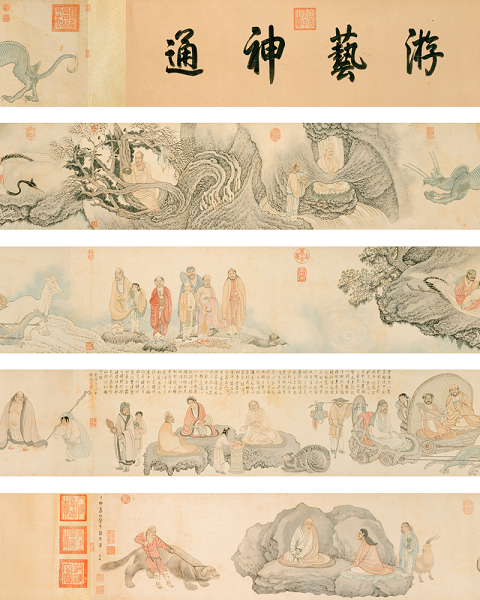
地产商华人置业(Chinese Estate)董事局主席,香港大富豪刘銮雄(Joseph Lau)因敏锐挖掘低估价股票的独到眼光,被人冠以股市"狙击圣手"的称号。生意场外的这位大亨行事张扬,生活奢靡,与众多女星有染,是香港八卦小报的常客。
但是,刘在香港之外更多地是以一位痴迷的艺术品藏家著称,几年来他的收藏涉猎极广,上至中国古董,下至现代绘画作品。
刘氏本人从加拿大的滑铁卢大学(University of Waterloo)获工科学位后,于20世纪70年代从其父手上接过吊扇厂,之后他转向贸易行业发展。
他30多年前涉足收藏业,据报道他在国际拍卖会上的第一件拍品可追溯到1990年,当时他在佳士德拍卖会(Christie)上花了不到一百万美元竞拍到了一枚清朝乾隆皇帝的玉玺和一斗彩大花盆(doucai jardinière)。
去年,刘氏在日内瓦苏富比拍卖行(Sotheby)花了948万美元拍到了一颗7.03克拉重的蓝色钻石。近日,他是《裸体、绿叶和半身像》(Nude, Green Leaves and Bust)的八位竞拍人之一,这幅毕加索1932年创作的油画在本月的拍卖会上最终以一亿六百五十万美元成交。
刘銮雄最终是否抱得名画归不得而知:无论是佳士德还是苏富比都拒绝对此发表任何评论。
何鸿燊(Standley Ho)
在新葡京赌场(Grand Lisboa)的大厅,立着一尊澳门赌界大佬、拥有新葡京赌场超半股份的何鸿燊半身雕像。在其雕像身后,放置着他2007年花了八百八十万美元购得的圆明园青铜马首像。它是当时拍卖会拍出的清朝最贵的雕像,曾是圆明园(位于北京近郊的皇家避暑行宫)12生肖报时喷泉(俗称"水力钟")边的饰物之一,在19世纪遭劫后流失海外。
何鸿燊在香港的苏富比拍卖行购得马首后,这位热心公益的赛马会主席把它捐给了中国政府。在何未定具体由哪个政府部门接收期间,马首在新葡京赌场作短暂展览。
"我希望此举可以鼓励更多的国人共同努力拯救中华文物,培养爱国情怀,"88岁高龄的何鸿燊当时表示。
何似乎觉得只要能买回中国的历史,出再高的价都不为过。
2003年,他抢购下了水力钟的铜猪首,并把它捐给了政府背景的保利艺术博物馆。保利当时已拥有猴首、牛首和虎首。
2007年,何鸿燊花了180万美元购得一把清朝皇帝的龙椅。他其它的中国艺术藏品包括一尊用猛犸象牙雕刻的孙悟空像(the Monkey King,中国最喜闻乐见的民间形象)和一座模仿鸟鸣叫的清代皇家宝石镶钟(gem-engraved clock)。
刘益谦(Liu Yiqian)
说到中国大陆最知名的艺术藏家,来自上海的刘益谦、王薇夫妇(Liu Yiqian &Wang Wei)总是榜上有名。刘益谦的收藏原则是:"股票要买便宜的,艺术品要买贵的。"正是基于这样的原则,夫妇俩去年花了大约13亿人民币(1.16亿英镑)购买艺术品,其中以1.69亿元人民币买入16世纪明代画家吴彬的《十八应真图卷》(18 Arhats,Wu Bin,文章顶部图片),这是目前拍卖会上中国艺术品拍出的最高价。据刘自己说,这是"我一生最难忘的竞拍。"在香港苏富比拍卖行10月拍卖会上,他们夫妇以8578万元拍得乾隆御制紫檀"水波云龙"宝座(zitan imperial throne),这同样是中国家具目前拍出的最高价。
40多岁的刘益谦是一位初中缀学生,在20世纪80年代以100元人民币制作皮包起家。20世纪90年代,随着中国开始开放其金融市场,他放弃经商,转而投向债券和股票。很快他成了百万富翁,积累了巨额财富,并把它投入到自己渐趋上瘾的艺术品收藏中去,主要是中国古代绘画和古董。
王薇很小就喜欢上了艺术,当时她发现自己在绘画上有天份。她在20世纪90年代开始涉足收藏,喜欢收藏油画和雕塑,尤其是"红色经典"(代表1949后中国动荡岁月)的艺术作品。
管艺(Guan Yi)
管艺是中国当代艺术作品最具影响力的藏家。他出生在中国北方青岛一家从事化工生产的中产家庭,在2001年他放弃家族企业,转而全身心投入艺术收藏。他是中国大陆第一批当代艺术作品的买家,在这些作品走向世界之前,就开始大量抢购现代绘画、雕塑和装置。
"涉足收藏后,我就发现国人中没人收藏当代艺术作品,所有作品都流向国外。我觉得这不正常。我们这个时代的艺术作品很重要,国人应该多买入,"44岁的管艺说。
管艺现已收藏大约800幅当代作品。然而,他对中国艺术家的作品价格扶摇直上颇为不满。他说当代的艺术作品演变成了商品,大家都当作股票来买。
他说,这在中国的藏家中尤甚,十之八九(中国当代艺术家的)作品都让他们买走了。十年前,(购买中国当代艺术作品的)买家中只有十之一二是中国人。"这明显是资本逐利的方式。中国没有真正意义的宗教,现在资本主义成了万众敬捧的神",管艺说。
管艺在宋庄(Songzhuang,北京东郊知名的艺术聚居区)有座私人博物馆,目前正在寻求政府审批,以建造一座10倍于现有规模的博物馆。
人物小传由英国《金融时报》刘励和撰写
译者:常和
http://www.ftchinese.com/story/001033474

THE COLLECTORS
Joseph Lau
The chairman of Chinese Estates, a property developer, one of Hong Kong's richest men, Joseph Lau is nicknamed a "stock market sniper" for his talent in profiting from the trading of undervalued shares. Apart from business, the flamboyant tycoon's lavish lifestyle and relationships with different women. appear regularly in the city's tabloids.
Outside Hong Kong, however, he is perhaps best known as an avid art collector, whose tastes have ranged from Chinese antiques to modern paintings through the years.
Armed with a science degree from the University of Windsor in Canada, Lau inherited a fan-making business from his father in the 1970s, then branched out into trading.
He started collecting more than 30 years ago: one of his first reported purchases at an international auction dated back to 1990, when he paid less than $1m for an imperial seal mark from the Qianlong period of the Qing dynasty and a doucai jardinière at Christie's.
Last year, Lau bought a 7.03-carat blue diamond for $9.48m at Sotheby's Geneva. More recently, he was one of the eight bidders for "Nude, Green Leaves and Bust", the 1932 Picasso that sold at auction this month for $106.5m.
Whether he eventually took the masterpiece home remains a mystery: neither Christie's nor Chinese Estates would comment.
Stanley Ho
In the lobby of the Grand Lisboa stands a bust of Stanley Ho, the gaming mogul and majority owner of the Macao casino. Behind him lies a bronze horse-head sculpture he bought for a record $8.8m in 2007. The work – the most expensive Qing dynasty sculpture sold at auction – is one of the 12 heads of zodiac animals which graced a water-clock fountain in Yuanmingyuan, the imperial summer palace near Beijing, that was looted in the 19th century.
When Ho bought the sculpture through Sotheby's Hong Kong, the avid racehorse owner donated it to China. It is on temporary display in the Grand Lisboa while Ho decides which government department to give it to.
"I hope this will encourage more people to join efforts in preserving China's cultural relics and nurture patriotic feelings," Ho, 88, said at that time.
Ho seems to think that no price is too high to buy back China's history.
In 2003, he snapped up the clock's boar head and gave it to Beijing's state-backed Poly art museum, which also has the monkey, ox and tiger heads.
In 2007, Ho bought an imperial throne of the Qing dynasty for $1.8m. His other collections of Chinese works of art include a mammoth tusk carving of the Monkey King, one of the country's best-known legendary figures, and an imperial, gem-engraved clock from the Qing period that imitates the sound of birds.
Liu Yiqian
When it comes to art collectors, Shanghai businessman Liu Yiqian and his wife Wang Wei are among the most famous in China. Driven by Liu's rule of collecting – "one should buy shares that are cheap and art pieces that are expensive" – the couple spent an estimated Rmb1.3bn (£116m) last year on buying art, including "18 Arhats", a 16th-century scroll painting by Ming dynasty painter Wu Bin that was sold for Rmb169m, the highest price for any Chinese artwork in auction. It was "my most memorable purchase", according to Liu. In Hong Kong, they also set a record for Chinese furniture after paying HK$85.7m for a zitan imperial throne from the Qing dynasty through Sotheby's in October.
Liu, a high school dropout now in his 40s, started a company making bags with Rmb100 in the 1980s. As China began to open up its financial markets in the 1990s, he gave up the business and went into bonds and shares trading. That helped him become a millionaire and build the war chest to fund his newfound interest in collecting art, mainly classical paintings and antiques.
Wang got interested in art at a very young age when she realised her talents in drawing. She started collecting in the 1990s, and is fond of oil paintings and sculptures, especially "red classics" – art pieces that symbolise China's turbulent decades after 1949.
Guan Yi
Guan Yi is China's most influential collector of contemporary art. Born to a middle-class family that runs a chemical manufacturing company in Qingdao in north-east China, Guan left the family business in 2001 to become a full-time collector. One of the first buyers of Chinese contemporary art on the mainland, he started snapping up many modern paintings, sculptures and installations before they became global phenomena.
"After I started, I realised that no Chinese was buying contemporary art and that everything was going abroad. I thought this was not right. This art of our time is important and we Chinese should buy more of it," Guan, 44, says.
Guan has now acquired about 800 such works. In spite of that, he is not happy with the soaring prices of Chinese artists. He says contemporary art has become such a commercial product that people are buying it as if it was stock.
This is, he says, especially true among Chinese collectors, who buy four out of five works now. Ten years ago, only one in five buyers was Chinese. "This is clearly a very capitalistic approach. There is no religion in China. Capitalism is god now," says Guan.
He is now seeking government approval to build a museum that would be 10 times bigger than his current private museum in Songzhuang, a popular art district in the east of Beijing.
Profiles by Justine Lau
没有评论:
发表评论